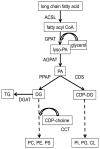Dietary polyunsaturated fatty acids and inflammation: the role of phospholipid biosynthesis
- PMID: 24152446
- PMCID: PMC3821664
- DOI: 10.3390/ijms141021167
Dietary polyunsaturated fatty acids and inflammation: the role of phospholipid biosynthesis
Abstract
The composition of fatty acids in the diets of both human and domestic animal species can regulate inflammation through the biosynthesis of potent lipid mediators. The substrates for lipid mediator biosynthesis are derived primarily from membrane phospholipids and reflect dietary fatty acid intake. Inflammation can be exacerbated with intake of certain dietary fatty acids, such as some ω-6 polyunsaturated fatty acids (PUFA), and subsequent incorporation into membrane phospholipids. Inflammation, however, can be resolved with ingestion of other fatty acids, such as ω-3 PUFA. The influence of dietary PUFA on phospholipid composition is influenced by factors that control phospholipid biosynthesis within cellular membranes, such as preferential incorporation of some fatty acids, competition between newly ingested PUFA and fatty acids released from stores such as adipose, and the impacts of carbohydrate metabolism and physiological state. The objective of this review is to explain these factors as potential obstacles to manipulating PUFA composition of tissue phospholipids by specific dietary fatty acids. A better understanding of the factors that influence how dietary fatty acids can be incorporated into phospholipids may lead to nutritional intervention strategies that optimize health.
Figures




References
-
- Calder P.C. Fatty acids and inflammation: The cutting edge between food and pharma. Eur. J. Pharmacol. 2011;668:S50–S58. - PubMed
-
- Calder P.C., Albers R., Antoine J.M., Blum S., Bourdet-Sicard R., Ferns G., Folkerts G., Friedmann P., Frost G., Guarner F. Inflammatory disease processes and interactions with nutrition. Br. J. Nutr. 2009;101:1–45. - PubMed
-
- Simopoulos A.P. Evolutionary aspects of diet, the ω-6/ω-3 ratio and genetic variation: Nutritional implications for chronic diseases. Biomed. Pharmacother. 2006;60:502–507. - PubMed
-
- Contreras G.A., Sordillo L.M. Lipid mobilization and inflammatory responses during the transition period of dairy cows. Comp. Immunol. Microbiol. Infect. Dis. 2011;34:281–289. - PubMed
-
- Sordillo L.M., Contreras G.A., Aitken S.L. Metabolic factors affecting the inflammatory response of periparturient dairy cows. Anim. Health Res. Rev. 2009;10:53–63. - PubMed
Publication types
MeSH terms
Substances
LinkOut - more resources
Full Text Sources
Other Literature Sources

